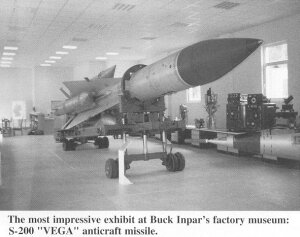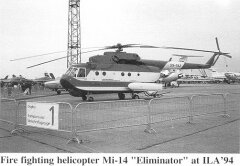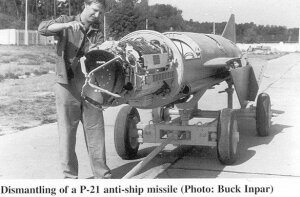| |
published in EUROAVIA News 06/1995

|
|
As a result of the reunification in 1990 Germany owned the complete weaponry of two well equipped armies. Both the
East German "Nationale Volksarmee" (National Peoples Army - NPA) and the West German "Bundeswehr"
belonged to the front line forces of their alliances. After the armed forces of the USA and the Soviet Union the two
German armies were the best equipped conventional military forces in Europe.
|
|
under the new economic conditions. Because of the German laws it was not possible to continue the missile production for export. Different projects were started, for instance the
production of windows and of residential containers. The West German firm Buck was found as a partner. Buck had
know-how in disposal of ammunition. Using the experiences of both Inpar Pinnow and Buck the new Buck Inpar started the
scrapping of missiles.
At the beginning of the destruction
|
|
During the Cold War about 700.000 soldiers served in the two German armies (500.000 in the West and 200.000 in the
East). After the reunification the strength of the all-German "Bundeswehr" was reduced to 370.000 soldiers.
Because of this fact and the signing of several disarmament treaties it was necessary to reduce the number of weapons
systems of all kind. Mostly weapons and equipment of the former
|

|
NPA fell a victim to these reductions. Not always worse performances of the Soviet built equipment caused this
decision.
But the disarmament of such a lot weapons systems of Soviet origin was also an advantage for some firms in East
Germany. They were able to use their knowledge in maintenance and licenced manufacture of Soviet designed arms to
offer a cheap and professional disposal. In the following I will give a report on two firms I visited last year. These
examples show interesting conceptions and advantageous cooperation between people from both parts of Germany.

On September 20, 1994 the last one of 6418 large scale missiles of the former NPA was disposed by the firm Buck
Inpar in Pinnow in the north of Berlin. This was the end of the first phase of a work that began in 1991. Before the
reunification Industriepark (Inpar) Pinnow was a maintenance center for all missiles of the GDR air defence. Since
1986 there was produced the anti-tank guided missile "Konkurs" (NATO code name AT-5 "Spandrel")
under Soviet licence for both the GDR army and customers inside and outside the Warsaw pact. After 1990 the employees
of the firm looked for new markets to survive
|
|
process every missile is checked carefully. After that it will be divided in small parts. Solid propellants are cut under water. Parts contenting only
small quantities of explosives are destroyed in vacuum chambers. New technologies are used to realize a
environment-friendly disposal. In a recycling plant developed by Buck explosives are decomposed in not dangerous
components. Liquid missile propellants are prepared for further processing. Plastic parts of signal rockets were made
into coat hangers and the residue of aluminum smelting was used as a additive at street building.
Until now Buck Inpar scrapped more than 42.000 tons of ammunition, among them more than 400.000 missiles of every
size. The biggest parts to be scrapped were the anti-aircraft missiles "Dvina" and "Volkhov" (SA-2
"Guideline"), "Neva" (SA-3 "Goa"), "Krug" (SA-4 "Ganef"),
"Vega" (SA-5 "Gammon"), "Kub" (SA-6 "Gainful") as well as the anti-ship
missiles P-15 and P-21/22 (SS-N-2 "Styx"). One sample of every type of missile destroyed in Pinnow is kept
in a factory museum. A visit to this museum is a unique chance to have a look at the whole missile armoury of a modern
army.
The scrapping of small unguided air-to-ground rockets and rockets for multiple rocket launchers will continue until
the end of 1996.
|
 After that the disposal of ammunition will be only a small part of the business of Buck
Inpar. Until then the other fields
of Buck's production will be able to survive without the money earned with missile disposal. Especially new
technologies for house building, microbiological decontamination of soil and for production engineering will be basis
for Buck Inpar's success in the future. Today already more people work in Pinnow than during the times of armament
production.
After that the disposal of ammunition will be only a small part of the business of Buck
Inpar. Until then the other fields
of Buck's production will be able to survive without the money earned with missile disposal. Especially new
technologies for house building, microbiological decontamination of soil and for production engineering will be basis
for Buck Inpar's success in the future. Today already more people work in Pinnow than during the times of armament
production.

One of the most interesting exhibits at ILA'94 in Berlin was the fire fighting helicopter Mi-14 "Eliminator"
presented by the firm Aerotec. Aerotec was founded as a small maintenance firm in 1986 in
Saarbruecken. In 1993 it
moved to Rothenburg in East Germany near the Polish border. Reasons for this move were some advantages of the
location, especially the large number of highly qualified former NPA soldiers, the nearness of possible markets in
Eastern Europe and the opportunity to use the facilities of a former East German air defence base.
Today Aerotec is an important economic factor in the underdeveloped area in the far east of Germany. Beside conversion
the firm is active in other scopes of business. Aerotec Airways offers scheduled and charter air traffic. Two former
NPA airplanes L-410 are used for this purpose. In addition there are created capacities for maintenance of Aerotec
operated aircraft. In the future it may be possible to maintain larger aircraft from other owners also.
In spite of these activities conversion is the most important business
|
|
version of the Soviet naval combat
helicopter Mi-14 (NATO code name HAZE). In 1990 the GDR People's Navy owned 8 helicopters of the PL counter submarine version and 6 of
the BT version equipped for mine sweeping. Nine of these helicopters were bought by Aerotec from the government for
conversion to fire fighters.
A lot of work had to be done before the first "Eliminator" was ready for take off. Many parts of the
avionics were exchanged for Western ones. The first prototype is fitted out with a fire fighting system developed by a
US firm. For the future the development of an own system is planned. The helicopter carries 4.500 liters of water and
500 liters extinguishing means in internal tanks. Compared with other helicopters used for fire fighting internal
housing of the water supply is a big advantage of "Eliminator", because flying characteristics are not made
worse. Filling the tanks takes only two minutes. Water can be taken over from nearly every body of water. Different
water drop modes are possible.
Most of the helicopters will be operated by Aerotec, flown by its own crews. Experts from Spain, Portugal and USA are
interested in the flying fire fighter.
Beside the fire fighting helicopter programme the demilitarization of aircraft and aircraft components intended for
showing in museums is a very important part of Aerotec's activities recently. Different GDR Air Force types like
MiG-21 and Su-22 lose their armaments and get a touched up outfit. Aerotec was also responsible for the preparation of
20 L-39 Albatros for shipping to Hungary.
For the future many very interesting projects are planned. A joint venture with the Russian helicopter builders in
Moscow and Kasan will enable the further use of many Mil helicopters in Germany. An aerosol fire fighting equipment
based on jet engines of scrapped combat aircraft should be developed and produced. It is to be expected that Aerotec
will attract attention with some unconventional projects in the next few years.
|
|
of
Aerotec. Based on the knowledge of former
NPA technicians there are realized many different programmes for using former NPA combat equipment for civil use. The best
example for the success of Aerotec's efforts in conversion is the mentioned fire fighting helicopter
"Eliminator". This helicopter is a demilitarized and completely rebuilt
|

|

| | |